You like chickens, and I like the color blue, so why don’t we talk about blue chickens?
Today, we will be discussing 9 blue chicken breeds that would undoubtedly add a touch of color to your flock.

When I first entered the poultry world, I thought blue chickens sounded a little absurd. However, in time, I grew to know that they are more common than one would think.
There are many blue critters littering chicken handlers’ runs. However, they are not that noticeable because they usually do not come in the shades of blue you might be expecting. More often than not, the blue hue is not that prominent – it’s pretty muted, actually. Sometimes, it takes a good look to see the blue covering.
Blue Chicken Breeds Chart
| Breed | Lifespan | Weight | Egg Production |
| Blue Cochin | 5 – 8 years | 10 – 11 lbs | Normal |
| Blue Laced Red Wyandotte | 5 – 8 years | 6.5 – 8.5 lbs | Good |
| Blue Silkie | 7 – 8 years | 2 – 3 lbs | Good |
| Blue Andalusian | 5 – 8 years | 5 – 7 lbs | Less |
| Blue Sumatra | 6 – 8 years | 4 – 5 lbs | Less |
| Blue Bresse Gauloise | 5 – 8 years | 7 – 8 lbs | Good |
| Blue Dutch Bantam | 4 – 8 years | 10 – 12 lbs | Good |
| Blue Ameraucana | 7 – 8 years | 4.5 – 6.5 lbs | Good |
| Delaware Blue Hen | 5+ years | 4 – 5 lbs | Good |
| Blue Australorp | 7 – 8 years | 6.5 – 10.0 lbs | Good |
1. Blue Cochin
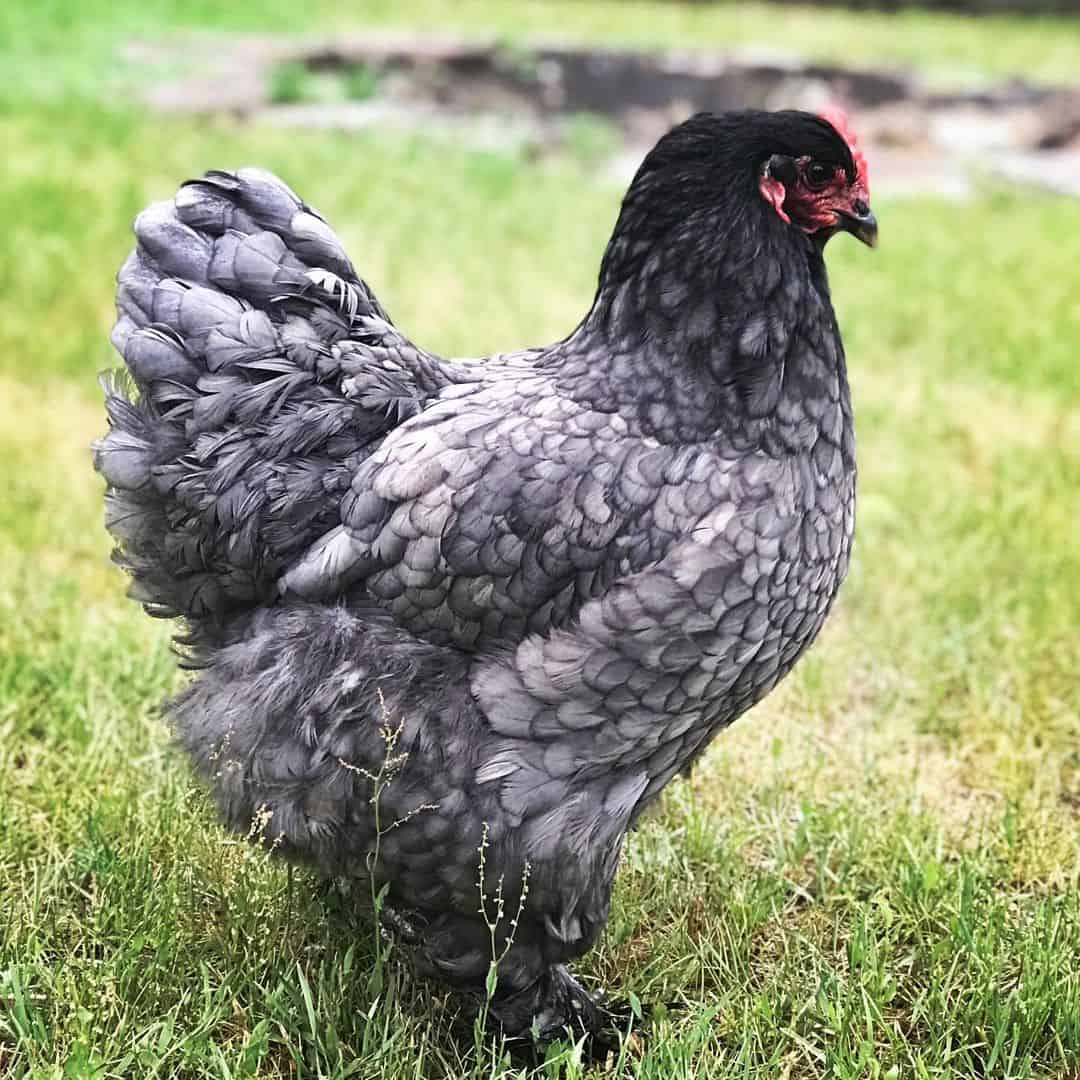
- Lifespan: 5 – 8 years
- Weight: 10 – 11 lbs
- Egg Production: Normal
- Egg Color: Brown
- Egg Size: Medium
Let us start with a crowd favorite – the Cochin.
The Cochin is quite popular in the poultry world for many reasons. This bird charms the people it meets by greeting them as a big ball of fluff with a friendly face. After that, they seal the deal with hugs and kisses.
There are several variants of this chicken. One of those is the Blue Cochin. Unlike their other colored comrades, the Blue Cochin also exudes elegance in addition to their widely known adorableness. They still look like walking furballs, just with some added sophistication. With that said, it comes as no surprise that chicken moms and dads search for them despite being somewhat hard to come by.
These fowls are loveable, and there is no doubt about that. However, they are not the most productive birds on the block. They could give you an average of 2 eggs a week, totaling around 100 eggs each year. On the other hand, you could rely on these ladies for eggs when the other hens have decided to settle down and take a break when the winter season arrives.
If you are interested in the Cochins but looking for something a little more unique, then the Blue Cochins could be both fetching and endearing at the same time.
2. Blue Laced Red Wyandotte

- Lifespan: 5 – 8 years
- Weight: 6.5 – 8.5 lbs
- Egg Production: Good
- Egg Color: Brown
- Egg Size: Large
Next up, we have the Blue Laced Red Wyandotte.
The Wyandotte is another common chicken in the poultry world, and while she is common, she sure is pretty. We understand that it could be intimidating to just add a new breed to your family. Sometimes, no amount of research could prepare you for the real thing. So, if you are looking for something new but do not want to stray from what is already familiar, the Blue Laced Red Wyandotte might be for you.
The Wyandotte is an overall great chicken. It is a dual-purpose breed that could give both eggs and meat to its handler, making it a good choice for those looking for productive fowls. Furthermore, known as a calm and friendly critter, it also has a great personality, making it a good choice if you are looking for a barnyard companion.
The Blue Laced Red Wyandotte has all these desirable qualities just with the extra quirkiness when it comes to appearance. If you’re looking to add some color to your family, or just something new and fresh to the flock, then the Blue Laced Red Wyandotte would be a good and safe choice. This is especially true if you are starting. They would both stand out and fit right in!
3. Blue Silkie
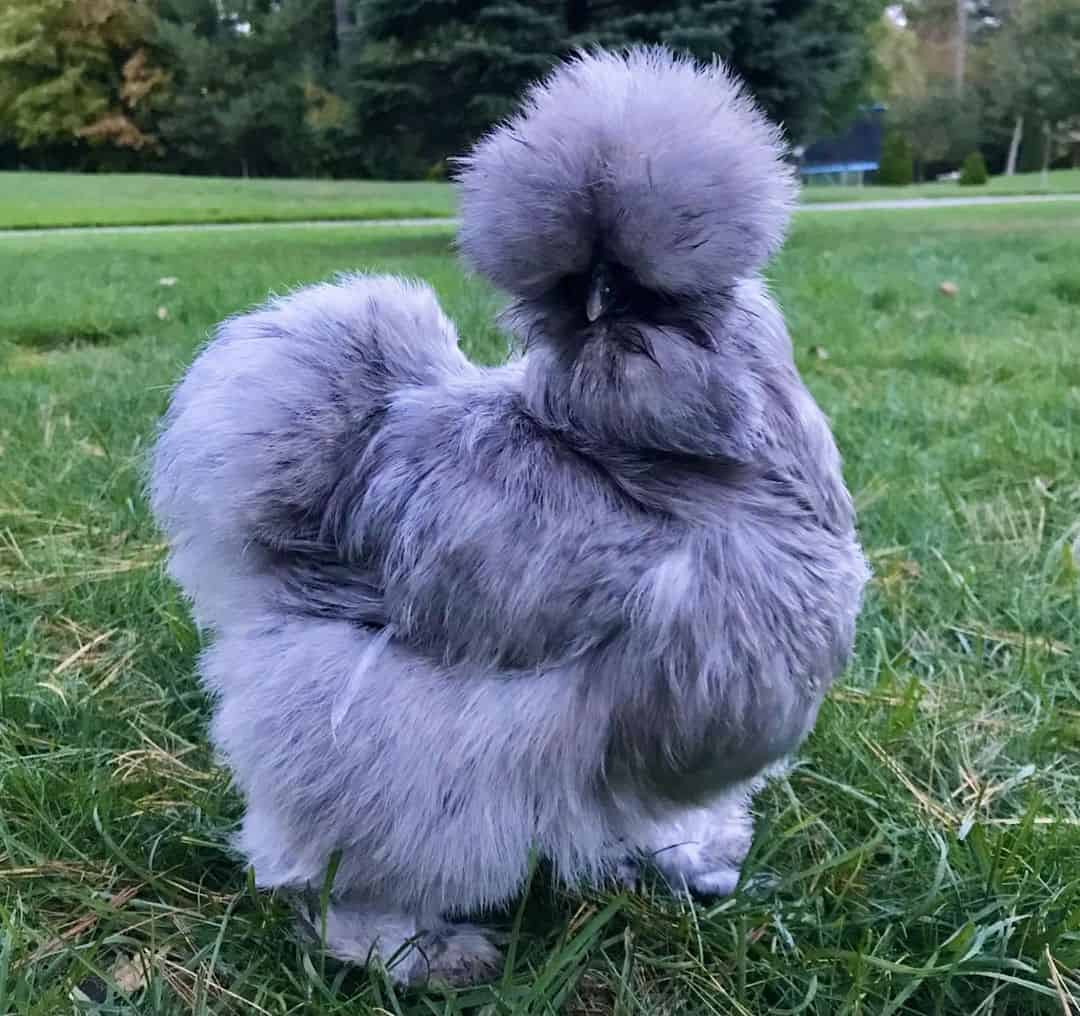
- Lifespan: 7 – 8 years
- Weight: 2 – 3 lbs
- Egg Production: Good
- Egg Color: Cream to tinted
- Egg Size: Small to medium
Here, we have the Blue Silkie.
If you want to go for something unique and different, then the Blue Silkie might be the perfect bird for you.
The Silkies are lovable little creatures. They are the perfect birds for you if you want to see some adorable little critters strutting on your run. Furthermore, there is no doubt you should add them to the family if you want a huggable fowl. They are friendly chickens and would most probably welcome the hugs. Trust me, you would want to cuddle with them at least once.
Furthermore, you could also depend on these guys for some eggs and meat. They could give you around three eggs a week, which would total to around 150 eggs each year. Furthermore, they may be small birds, but they offer great meat. Under all those feathers, these chickens have black skin, meat, and even bones! They have been considered a delicacy in other countries and an essential ingredient to some of their medicines.
The Blue Silkie offers all these and more! This bunch would add the touch of color and eccentricity your run may need. However, they are not the easiest birds to find. You might face some problems in your search for these critters.
4. Blue Andalusian
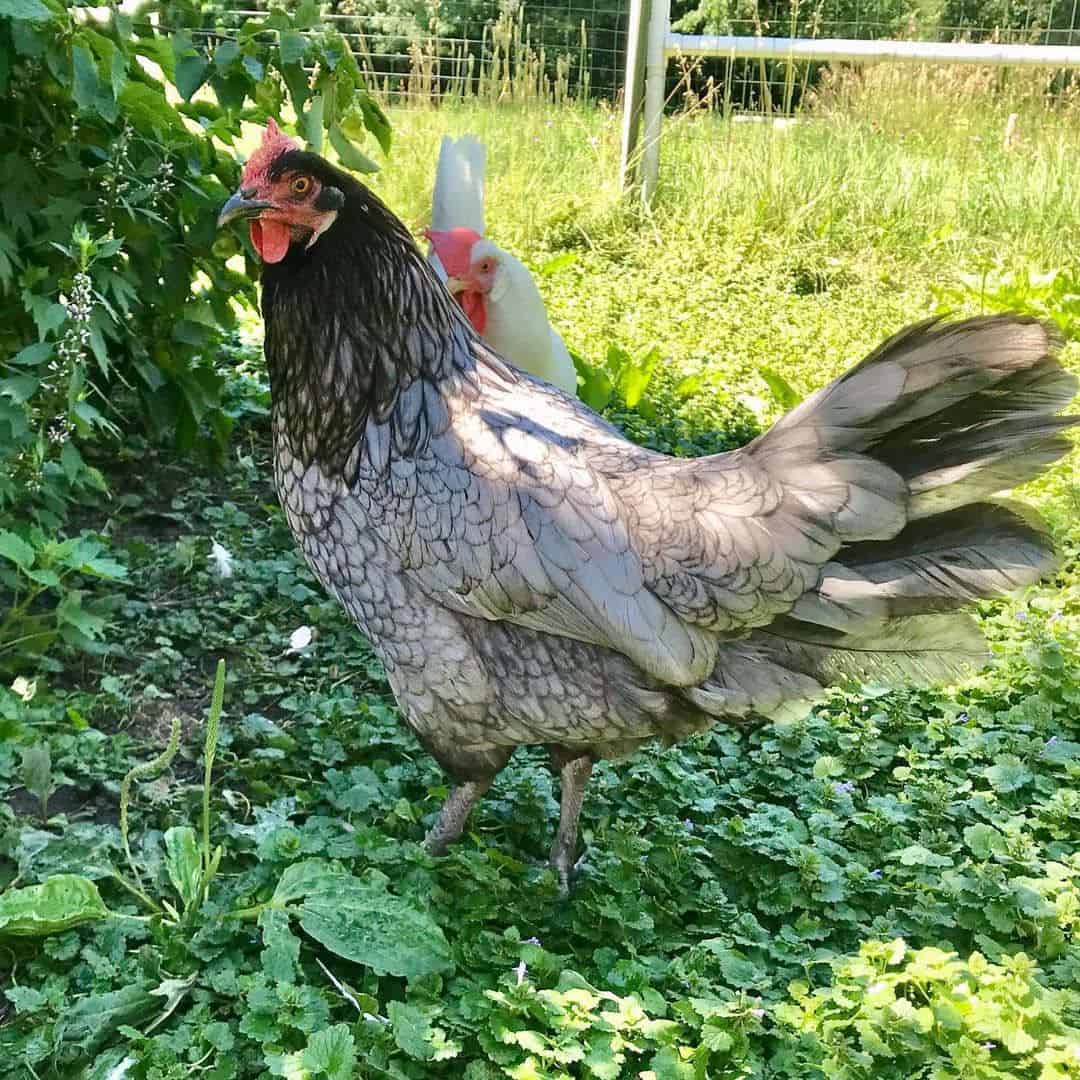
- Lifespan: 5 – 8 years
- Weight: 5 – 7 lbs
- Egg Production: Less
- Egg Color: White
- Egg Size: Large
We have been talking about the cuddly fellas. Now, if you are up for some challenge, then our next bird would be for you.
The Blue Andalusian is not your typical bird. While the previous chickens will have no problem being hugged and picked up, these birds would politely decline. They are not aggressive fowls, and they might even come to greet you, but they like their space. You might have a better chance of catching their love and attention if you have some treats to bribe them with when you come to visit.
Furthermore, the Blue Andalusian is an adventurer. It does not like being confined. It lives to be free!
You would have to let these birds roam, or they might resort to plucking their beautiful feathers. Furthermore, it would be pretty vocal about its frustration. You would have a noisy bird on your hands.
If you are looking for something different, not only in color and appearance, then the Blue Andalusian is a bird you should consider. It is a breed that will make you step up your game. You might have to expend a little more effort and energy, but we believe it will be all worth it! Learn more about Andalusian Chicken.
5. Blue Sumatra
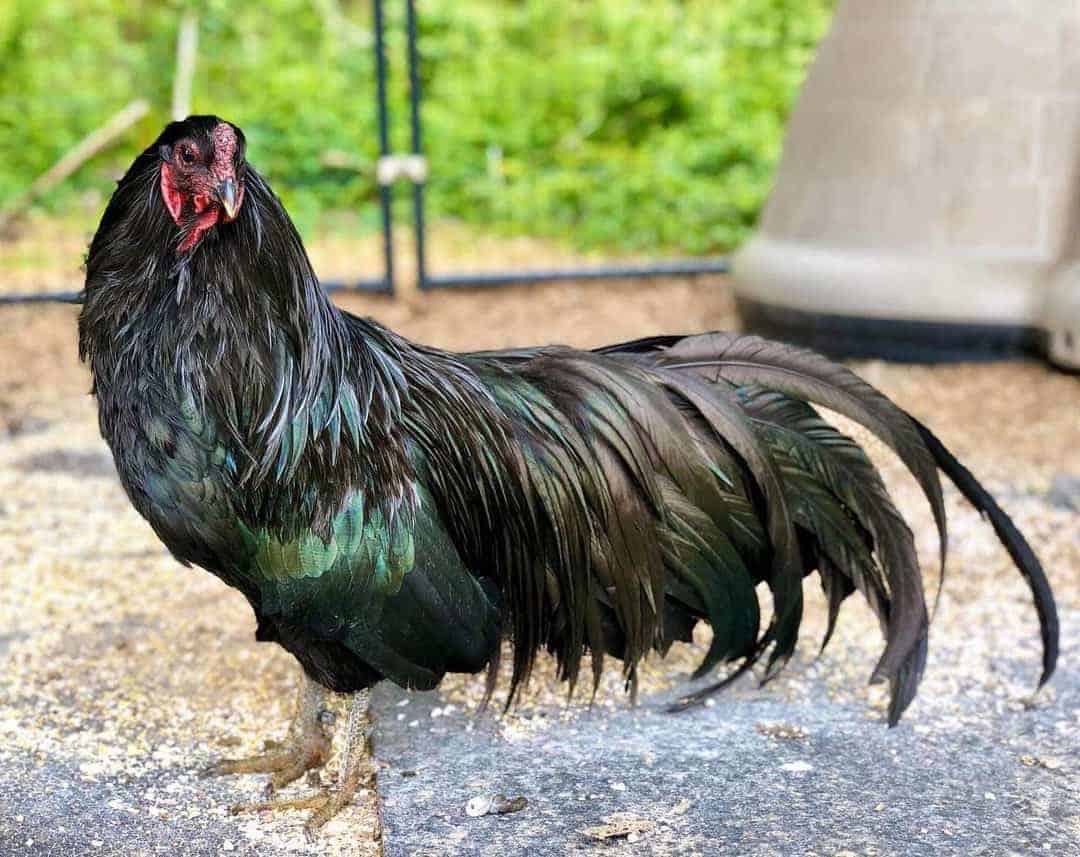
- Lifespan: 6 – 8 years
- Weight: 4 – 5 lbs
- Egg Production: Less
- Egg Color: White
- Egg Size: Medium
The fifth chicken we are about to discuss is truly an intriguing breed. It might just make you think if it is actually a chicken.
The mystery regarding the identity of this breed is not in how they look. They undoubtedly look like chickens – an elegant one at that. Some may have wondered if these guys really belong in the poultry world because of their origins.
We are sure the Blue Sumatra is a chicken, but the belief is that they are not merely an offspring of some ancient chickens but the descendants of other birds and fowls. This belief is further confirmed by their ability to fly. We are not talking about the short flights your backyard chickens do. They are one of the few chickens in the poultry world that could actually reach a reasonable distance.
However, we do hope their appearance has caught your heart. The Blue Sumatras are great ornamental birds, especially with their blue-tinted feathers, but are not the most productive chickens around. On average, they only give one egg per week. Furthermore, they are not great table birds as well.
If you think the Black Sumatras are rare, the Blue Sumatra might just be scarcer. The addition of the Blue Sumatra to your flock would undoubtedly be a fine touch of blue to your run.
6. Blue Bresse Gauloise

- Lifespan: 5 – 8 years
- Weight: 7 – 8 lbs
- Egg Production: Good
- Egg Color: White
- Egg Size: Large
Over here, we have the Blue Bresse Gauloise, a very posh breed, if I may say.
The Bresse Gauloise is a French breed. At first glance, it does not offer much, and you might not give it a second look. It is not eye-catching, and many birds share their physical characteristics. At one point in history, some traders even gathered identical-looking birds and sold them as Bresse Gauloise. However, these chickens are good examples of what you would say “more than meets the eye.”
They were known to be dual-purpose birds. However, as time passed, they dominated the meat market in the poultry world by giving one of the most delicious muscles you will ever taste. They could still provide a good number of eggs producing around 200 each year. However, they are now mainly bred to be premium table birds.
The Blue Bresse Gauloise offers all that with a bonus. Their blue plumage adds a touch to the usual Bresse Gauloise’s somewhat plain appearance. In addition, their blue feathers perfectly match their blue feet. Now, that is a trait you do not get to see every day. Let us try and see if any merchant could fake that now.
7. Blue Dutch Bantam
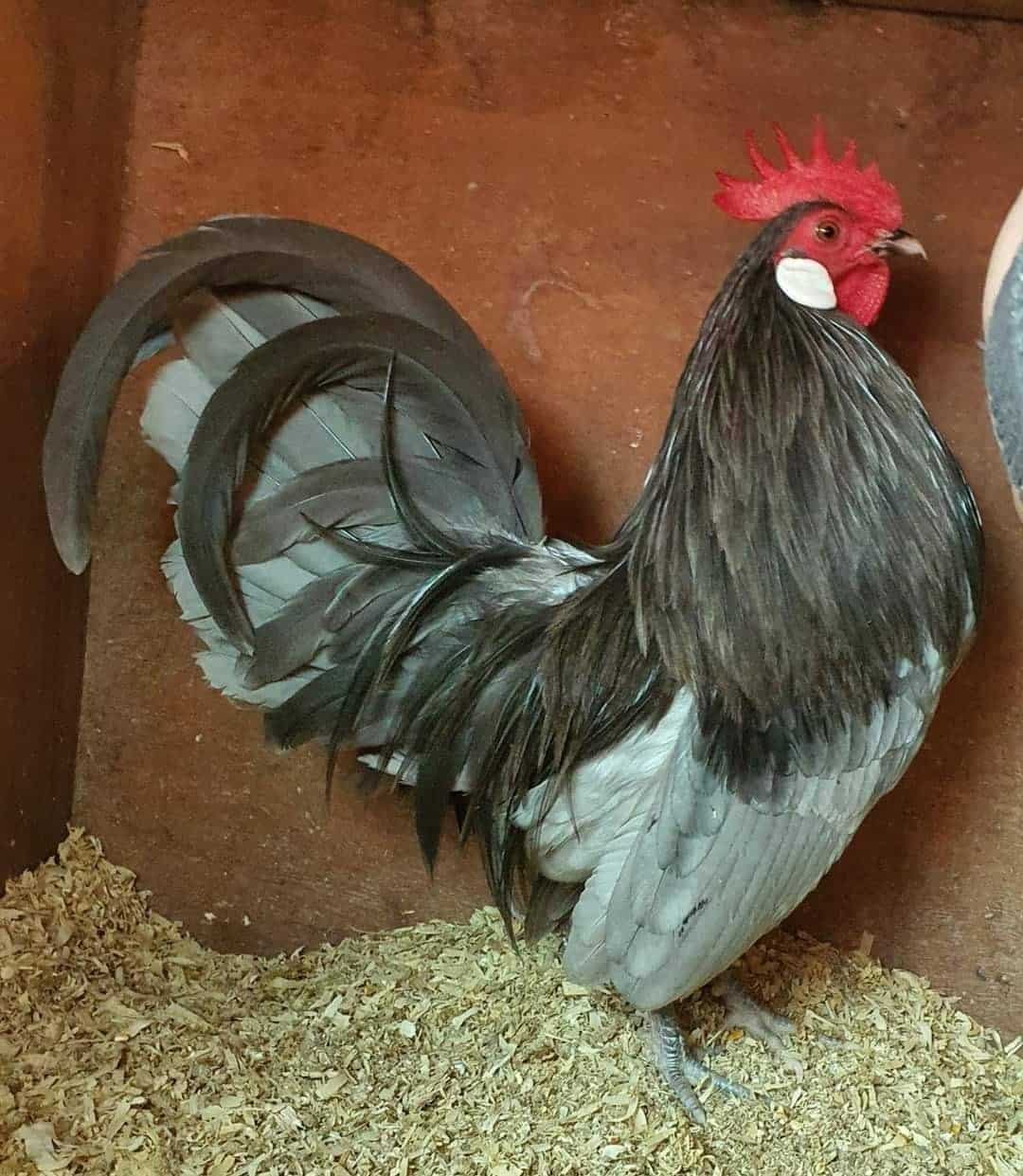
- Lifespan: 4 – 8 years
- Weight: 10 – 12 lbs
- Egg Production: Good
- Egg Color: Brown
- Egg Size: Medium to large
If you are into smaller breeds, then let me introduce you to another bantam – the Blue Dutch Bantam.
The Dutch Bantam is one of the most common chickens in the poultry world, especially if one is into show birds. It is a great breed to start with as it is known to be docile and friendly. If you have some little kids who want to try their hands with chickens, then you can let them handle a few Dutch Bantams.
Despite being known as an ornamental bird, you can also depend on these birds to be somewhat productive. They can give you around 2-3 eggs a week, totaling around 150 eggs each year. However, they are not really table birds and will not be able to help in this area, so you might want to look for another fowl for your meat.
If you are looking for something new and different, then the Blue Dutch Bantam might be the unique addition you are looking for. They possess the same qualities as other Dutch Bantams, it may look new, but you’d be handling the same bird. Furthermore, their blue plumage might add a touch of color and personality to your flock, especially if you already own the other variants.
8. Blue Ameraucana
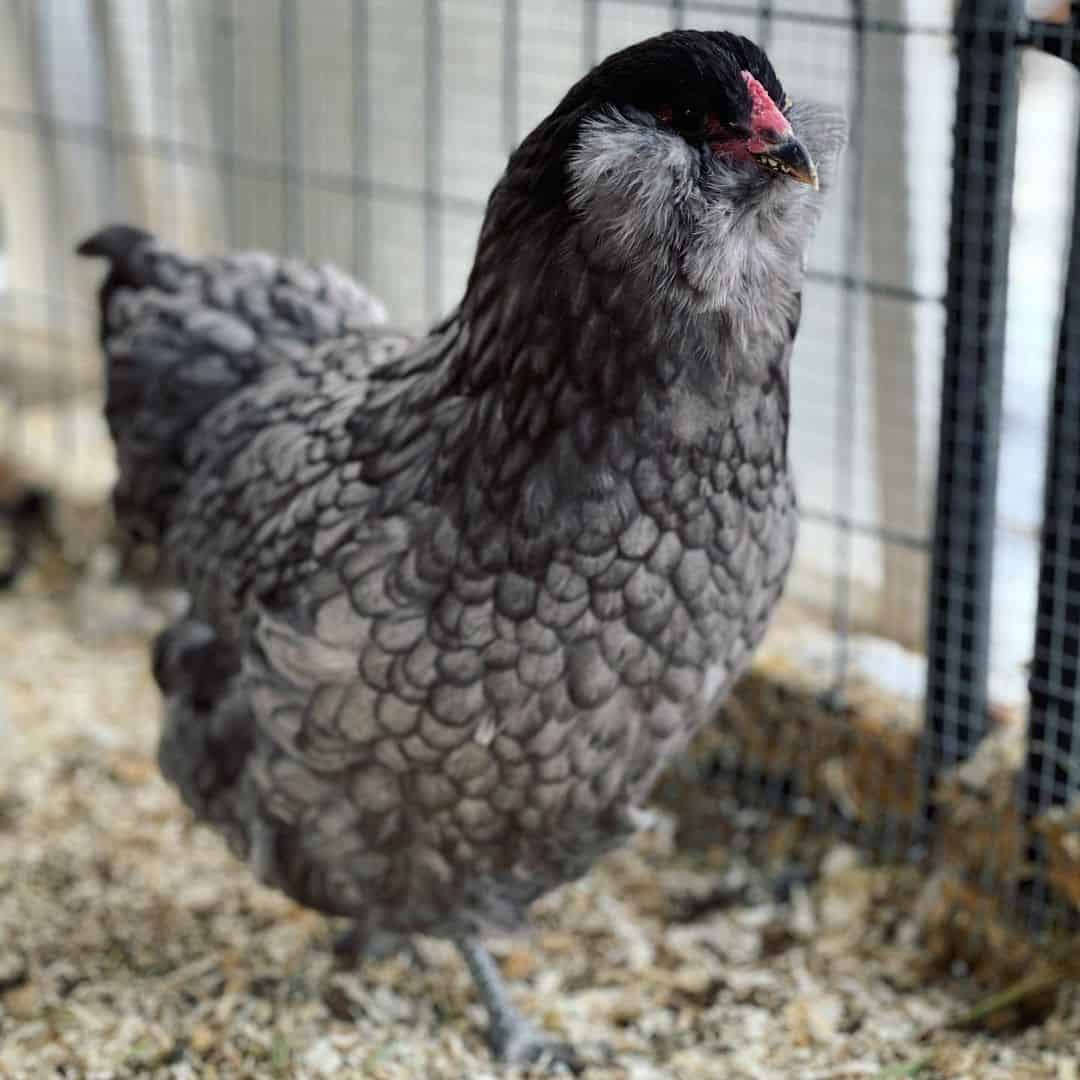
- Lifespan: 7 – 8 years
- Weight: 4.5 – 6.5 lbs
- Egg Production: Good
- Egg Color: Blue
- Egg Size: Medium
Some would think that blue chickens would immediately mean that they lay blue eggs. Unfortunately, that is not always the case. However, there are such birds. If you are looking for a blue chicken with blue eggs, we got the bird for you. Meet the Blue Ameraucana!
The Ameraucanas are undoubtedly a lot of fun. They have a few extra featherings on their faces that give them an adorable look. Furthermore, they know how to turn up the charm. These birds are known to be a friendly breed to both humans and other chickens. However, they still do like their space.
Furthermore, they might be a fun and cheery breed, but they do not make that much of a noise. If you would like to wake up to a quiet morning, or looking to avoid complaints from the neighbors, then the Ameraucana would be your bird.
Additionally, we said this breed gives you blue eggs. Well, they do not only provide colored eggs. You could say that they are also a productive fowl as they can give you around four eggs each week.
The Blue Ameraucana has all these characteristics, just with the added stylishness. If you are looking for some bluebirds on your run and blue eggs in your basket, they could provide both. More about Ameraucana Chicken.
9. Delaware Blue Hen

- Lifespan: 5+ years
- Weight: 4 – 5 lbs
- Egg Production: Good
- Egg Color: Brown
- Egg Size: Medium
Are you familiar with YoUDee? If you are familiar with “YoUDee”, the popular University of Delaware mascot, you ought to know that it is inspired by our next chicken.
The Delaware Blue Hen (sometimes also referred to as just the Blue Hen) is not a recognized chicken breed, but these fellas exist and are a sight to see. The history of these chickens is tied to the American Revolutionary War and cockfighting and their appearance seems like a perfect symbolization of these things.
The feathers on their breasts look somewhat like scales, and its shade of blue is the perfect color to make it look like a scale of steel armor. While these birds do not exactly look like they hold the fiery gaze most gamecocks sport, they sure do exhibit the elegance of a fighter.
These chickens do not only have their looks to offer. They are also known as a dual-purpose breed, and you can depend on them for eggs and meat. he Delaware Blue Hen typically produces around 250 medium eggs each year!
If you’re looking for something that could both satisfy your aesthetic and egg needs, the Delaware Blue Hen is a good option you would want to consider. They may not be officially recognized, but many chicken moms and dads love them all the same.
10. Blue Australorp
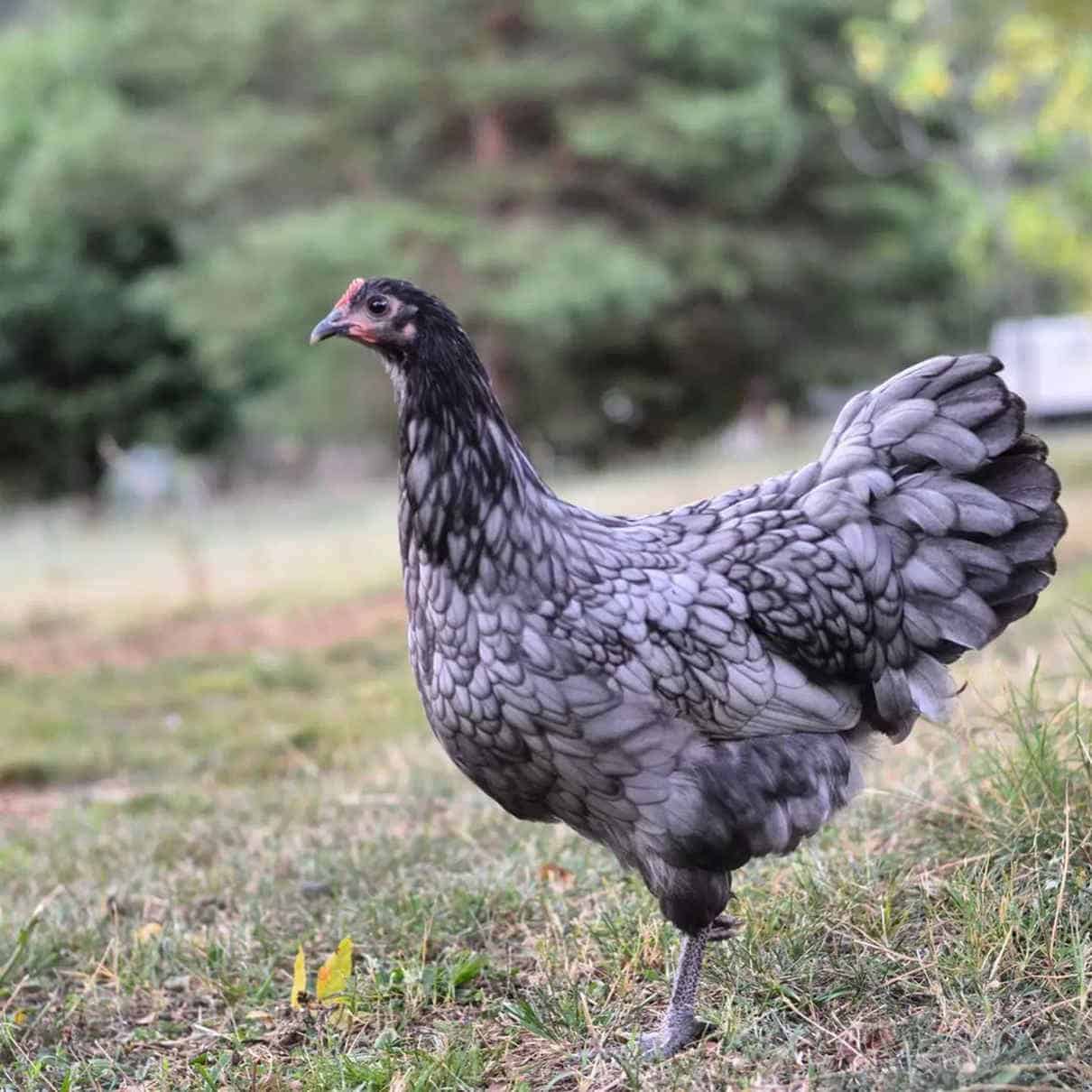
- Lifespan: 6-10 years
- Weight: 6.5 – 10.0 lbs
- Egg Production:
- Egg Color: Light brown
- Egg Size: Large
The Australorp chickens earned their names from their origins. You see, back in the 1800s, the Australians created their own breed from the Orpingtons. In those days, all that the Australians cared about was breakfast, so they prioritized egg production. And that’s exactly what they got.
With numbers like 250 eggs a year, who could be mad at the Australorp? But of course, egg production depends on the individual; some gals lay more eggs than others.
Generally, this bird comes in many colors, but blue is one of the most striking. From head to toe (except the red comb and wattles), the chicken is bathed in two tones of blue. In roosters, the dark blue tone dresses the neck, back, wings, and tail. The breast and underbelly are colored in a lighter tint of blue. In hens, the dark blue tone punctuates only their necks; the rest of their body is light blue.
Even though it was initially created to lay eggs, it turns out the Blue Australorp also packs a punch in the meat department. The roosters weigh between 8.5-10.0 lbs, while the hens come in at a respectable 6.5-7.5 lbs.
The Blue Australorp is a well-mannered chicken. It is docile and gets along great with humans and its fellow coop mates. But don’t think even for a single second that the Australorp is soft. The roosters are often protective of their hens. They keep an eye out for predators (both terrestrial and aerial). Australorp roosters are known to scare (or at least warn the flock) hawks and foxes.
In terms of health issues, Blue Australorp doesn’t suffer many problems. But all that egg-laying can take a toll on a gal. They can end up laying low-quality eggs or those with soft shells. But this is a problem that you can solve with calcium supplements. I heard oyster shells are quite effective.
Summary
There you have it, 10 blue chicken breeds!
Chickens come in all shapes and sizes, and apparently, all sorts of colors too. If you are looking to add a touch of color to your run, why not add a blue chicken or two to your family? They would surely make a fun and quirky addition to any flock.


Joseph Hudson has been raising chickens for over 15 years. In 2018, he completed the Agriculture & Natural Resources program at Mt. San Antonio College. He currently raises over 1400 chickens on his 7.5-hectare farm. He keeps sharing his experience on raising healthy and happy chickens on Chicken Scratch The Foundry.







